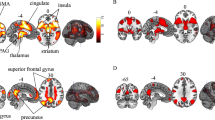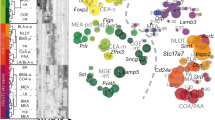Abstract
Family, twin and adoption studies provide evidence for a substantial genetic component underlying individual differences in general intelligence1, specific cognitive abilities2 and susceptibility to psychopathologies related to fear-inducing events3. Contextual fear conditioning, which is highly conserved across species, can serve as a model for elucidating genes that regulate individual differences in learning and emotion4–. In fear conditioning, an initially neutral stimulus, such as a tone or a particular environment (context), elicits a fear response after it has been paired with an aversive stimulus, such as shock. Two neural circuits have been implicated in fear conditioning. The fear component is regulated by amygdaloid pathways, while the contextual component is, at least in part, dependent on the hippocampus9–14. C57BL/6J (B6) and DBA/2J (D2) mice differ in several types of complex learning15,16, including contextual fear conditioning17. A quantitative trait locus (QTL) analysis of contextual fear conditioning was performed in a B6/D2 F2 intercross population. Two QTLs for contextual conditioning (lod score>4.3) were identified on chromosomes 10 and 16. QTLs for conditioning to the auditory cue (lod score>4.3) were localized to chromosomes 1 and 10. Suggestive QTLs (lod score=2.8–4.1) for contextual conditioning were detected on chromosomes 1,2 and 3.
This is a preview of subscription content, access via your institution
Access options
Subscribe to this journal
Receive 12 print issues and online access
$209.00 per year
only $17.42 per issue
Buy this article
- Purchase on Springer Link
- Instant access to full article PDF
Prices may be subject to local taxes which are calculated during checkout
Similar content being viewed by others
References
Bouchard, T.J., Lykken, D.T., McGue, M., Segal, N.L. & Tellegen, A. Sources of human psychological differences: the Minnesota study of twins reared apart. Science 250, 223–228 (1990).
DeFries, J.C. et al. Familial resemblance for specific cognitive abilities. Behav. Genet. 9, 23–43 (1979).
True, W.R. et al. A twin study of genetic and environmental contributions to liability for posttraumatic stress symptoms. Arch. Gen. Psychiatry 50, 257–264 (1993).
LeDoux, J.E. Brain mechanisms of emotion and emotional learning. Curr. Opin. Neurobiol. 2, 191–197 (1992).
LeDoux, J.E. Emotion: clues from the brain. Ann. Rev. Psychol. 46, 209–235 (1995).
Fanselow, M.S. Factors governing one-trial contextual conditioning. Animal Learn. Behav. 18, 264–270 (1990).
Adolphs, R., Tranel, D., Damasio, H. & Damasio, A.R. Fear and the human amygdala. J. Neurosci. 15, 5879–5891 (1995).
LaBar, K.S., LeDoux, J.E., Spencer, D. & Phelps, E.A. Impaired fear conditioning following unilateral temporal lobectomy in humans. J. Neurosci. 15, 6846–6855 (1995).
Bechara, A. et al. Double dissociation of conditioning and declarative knowledge relative to the amygdala and hippocampus in humans. Science 269, 1115–1118 (1995).
Scott, S.K. et al. Impaired auditory recognition of fear and anger following bilateral amygdala lesions. Nature 385, 254–257 (1997).
Phillips, R.G. & LeDoux, J.E. Differential contribution of amygdala and hippocampus to cued and contextual fear conditioning. Behav. Neurosci. 106, 274–285 (1992).
Kim, J.J. & Fanselow, M.S. Modality-specific retrograde amnesia of fear. Science 256, 675–677 (1992).
Phillips, R.G. & LeDoux, J.E. Lesions of the dorsal hippocampal formation interfere with background but not foreground contextual fear conditioning. Learn. Mem. 1, 34–44 (1994).
Logue, S.F., Paylor, R. & Wehner, J.M. Hippocampal lesions cause learning deficits in inbred mice in Morris water maze and conditioned fear tasks. Behav. Neurosci. 111, 104–113 (1997).
Upchurch, M. & Wehner, J.M. Differences between inbred strains of mice in Morris water maze performance. Behav. Genet. 18, 55–68 (1988).
Paylor, R., Baskall, L. & Wehner, J.M. Behavioral dissociations between C57BL/6 and DBA/2 mice on learning and memory tasks: A hippocampal-dysfunction hypothesis. Psychobiology 21, 11–26 (1993).
Paylor, R., Tracy, R., Wehner, J.M. & Rudy, J.W. DBA/2 and C57BL/6 mice differ in contextual fear but not auditory fear conditioning. Behav. Neurosci. 108, 810–817 (1994).
Blanchard, R.J. & Blanchard, D.C. Crouching as an index of fear. J. Comp. Physiol. Psychol. 67, 370–375 (1969).
Owen, E.H., Christensen, S.C., Paylor, R. & Wehner, J.M. Identification of quantitative trait loci involved in contextual and auditory-cued fear conditioning using BXD recombinant inbred strains. Behav. Neurosci. 111, 292–300 (1997).
Lander, E. & Kruglyak, L. Genetic dissection of complex traits: guidelines for interpreting and reporting linkage results. Nature Genet. 11, 241–247 (1995).
Lander, E.S. et al. MAPMAKER: an interactive computer package for constructing primary genetic linkage maps of experimental and natural populations. Genomics 1, 174–181 (1987).
Flint, J. et al. A simple genetic basis for a complex psychological trait in laboratory mice. Science 269, 1432–1435 (1995).
Market, P.D., Bennett, B., Beeson, M., Gordon, L. & Johnson, I.E. Mapping of quantitative trait loci for ethanol sensitivity in long-sleep and short-sleep mice. Genome Res. 7, 92–99 (1997).
Gershenfeld, H.K. et al. Mapping quantitative trait loci for open-field behavior in mice. Behav. Genet. 27, 201–210
Buck, K.J., Metten, P., Belknap, J.K. & Crabbe, J.C. Quantitative trait loci involved in genetic predisposition to acute alcohol withdrawal in mice. J. Neurosci. 17, 3945–3955 (1997).
Ferraro, T.N. et al. Mapping murine loci for seizure response to kainic acid. Mamm. Genome 8, 200–208 (1997).
Frankel, W.N. et al. New seizure frequency QTL and the complex genetics of epilepsy in EL mice. Mamm. Genome 6, 830–838 (1995).
Caldarone, B. et al. Quantitative trait loci analysis affecting contextual conditioning in the mouse. Nature Genet. 17, 335–337 (1997).
Abeliovich, A. et al. PKC-gamma mutant mice exhibit mild deficits in spatial and contextual learning. Cell 75, 1263–1271 (1993).
Aiba, A. et al. Reduced hippocampal long-term potentiation and context-specific deficit in associative learning in mGluR1 mutant mice. Cell 79, 365–375 (1994).
Bourtchuladze, R. et al. Deficient long-term memory in mice with a targeted mutation of the cAMP-responsive element-binding protein. Cell 79, 59–68 (1994).
Chen, C., Rainnie, D.G., Greene, R.W. & Tonegawa, S. Abnormal fear response and aggressive behavior in mutant mice deficient for α-calcium-calmodulin kinase II. Science 266, 291–294 (1994).
Lu, Y. & Wehner, J.M. Enhancement of contextual fear-conditioning by putative (±)-α-amino-3-hydroxy-5-methylisoxazole-4-propionic acid (AMPA) receptor modulators and /V-methyl-D-aspartate (NMDA) receptor antagonists in DBA/2J mice. Brain Res. (in the press).
Sambrook, J., Fritsch, E. & Maniatis, T. Molecular Cloning: A Laboratory Manual, 2nd ed. (Cold Spring Harbor Press, Cold Spring Harbor, New York, 1989).
Dietrich, W.F. et al. A genetic map of the mouse with 4,006 simple sequence length polymorphisms. Nature Genet. 7, 220–339 (1994).
Falconer, D.S. Introduction to Quantitative Genetics,3rd ed. 126 (Longman Scientific & Technical, John Wiley, New York, 1989).
Author information
Authors and Affiliations
Corresponding author
Rights and permissions
About this article
Cite this article
Wehner, J., Radcliffe, R., Rosmann, S. et al. Quantitative trait locus analysis of contextual fear conditioning in mice. Nat Genet 17, 331–334 (1997). https://doi.org/10.1038/ng1197-331
Received:
Accepted:
Issue Date:
DOI: https://doi.org/10.1038/ng1197-331
This article is cited by
-
Identification of a novel gene regulating amygdala-mediated fear extinction
Molecular Psychiatry (2019)
-
Differential Brain, Cognitive and Motor Profiles Associated with Partial Trisomy. Modeling Down Syndrome in Mice
Behavior Genetics (2017)
-
Introgression study reveals two quantitative trait loci involved in interspecific variation in memory retention among Nasonia wasp species
Heredity (2014)
-
Predictability and heritability of individual differences in fear learning
Animal Cognition (2014)
-
Effects of cued and contextual fear on sleep in DBA/2J mice
Somnologie - Schlafforschung und Schlafmedizin (2013)



